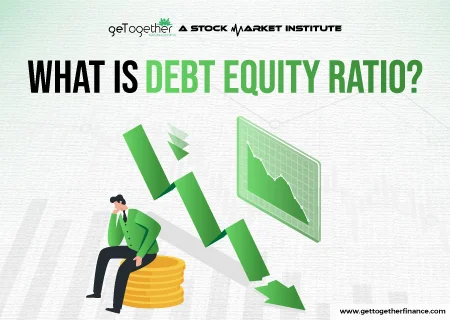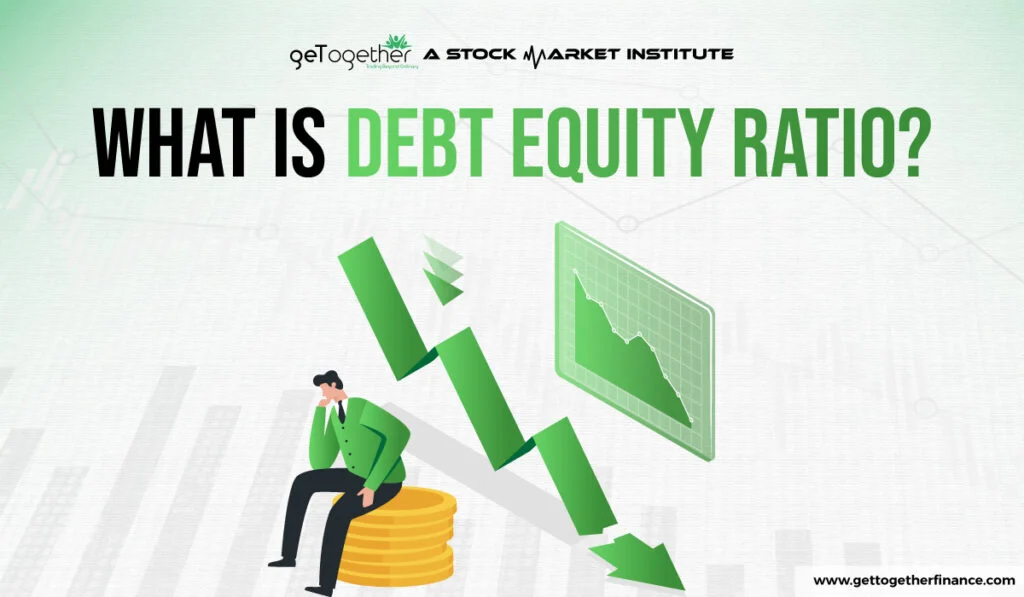What is Debt‑to‑Equity Ratio (D/E)


Table of Contents
ToggleOverview
In both business and the stock market, understanding key financial concepts is crucial for success. One such concept is the debt to equity ratio. This ratio, also known as the leverage ratio, goes beyond just measuring profit. It helps you understand how a company finances its operations – by using its own money (equity) or borrowed money (debt).
This blog will delve deep into the debt-to-equity ratio, explaining its definition, formula, and how to calculate it with some examples. We’ll also explore why this ratio is so important for both investors and businesses.
What is Debt to Equity Ratio?

The Debt-to-Equity (D/E) ratio, also known as ‘risk ratio’, ‘debt equity ratio’, or ‘gearing’ is a key financial tool that helps assess a company’s risk level. It compares how much a company owes (debt) to the money invested by its owners (equity). In contrast to the debt-assets ratio which employs total assets as the denominator, the debt equity ratio uses total equity instead.
This metric indicates whether a company’s capital structure is more heavily reliant on debt or equity for financing. This ratio is different from the debt-to-assets ratio because it focuses on equity instead of total assets. It helps investors and businesses understand how a company finances itself – through debt or equity.
Formula of Debt to Equity Ratio

Although there is one standard formula of debt- calculating the ratio. Here is the breakdown:
Short formula:
Debt Equity Ratio = Total Debt / Shareholders’ Equity
How to Interpret a Debt to Equity Ratio
A business does not need the lowest possible debt-to-equity (D/E) ratio to be successful. According to Lemieux, “A very low ratio can indicate that the company is very mature and has saved a lot of money over time.”
However, this might also suggest inefficient use of resources. While it’s essential to respect the risk tolerance of shareholders, a very low ratio could mean overly cautious management is missing growth opportunities.
Lemieux points out that minority shareholders in public companies often criticise the board for being too conservative, resulting in lower returns. For instance, minority shareholders aiming for a 15% return might be unhappy with just a 5% gain. Achieving higher returns typically requires investing in productive resources and using debt to leverage those investments.
Example of Debt to Equity Ratio
For instance, let’s take the example of Star Motors Limited. Here is the balance sheet as of June 30, 2024:
| Liabilities & Equity | Amount (₹ Thousand) |
| Current Liabilities | |
| – Trade Payables | 20,000 |
| – Short-Term Loans | 15,000 |
| – Accrued Expenses | 5,000 |
| Total Current Liabilities | 40,000 |
| Long-Term Liabilities | |
| – Long-Term Loans | 60,000 |
| Total Liabilities | 100,000 |
| Shareholders’ Equity | |
| – Share Capital | 30,000 |
| – Retained Earnings | 40,000 |
| Total Shareholders’ Equity | 70,000 |
| Total Liabilities & Equity | 170,000 |
Debt to Equity Ratio Calculation:
- Total Debt = ₹100,000
- Total Shareholders’ Equity = ₹70,000
Calculation: Debt Equity Ratio = ₹100,000 / ₹70,000 = 1.43
Interpretation: Star Motors Limited has a Debt to Equity Ratio of 1.43. This indicates that for every ₹1,000 of shareholder investment, the company has ₹1,430 of debt.
Also Read: Service Coverage Ratio
High vs. Low Debt-to-Ratio

A high debt to ratio shows that a company or individual has a significant amount of debt compared to its equity (assets minus liabilities). This can be a precarious position as businesses with high debt ratios may possess increased risk of default, limited borrowing capacity due to the debts, and show high vulnerability to economic downturns.
On the flip side, a low debt to ratio indicates that a company or individual has a significant amount of debt compared to its equity (assets minus liabilities). This can be a precarious position and is always indicates a good financial health of the company. The businesses low D/E ratio suggests stronger financial condition, greater financial flexibility, and increased confidence of investors in the company.
There’s no single “ideal” D/E ratio; it can vary depending on the industry, company size, and risk tolerance. However, it’s crucial to find a healthy balance between debt and equity. Companies with high growth potential may use a higher debt-to-ratio to finance expansion, while established companies may prioritise a lower debt load for stability.
Benefits of Debt to Equity Ratio

The Debt to Equity Ratio (Debt Equity Ratio) is a valuable tool used by both investors and businesses to assess financial health and make informed decisions. Here are some key advantages of using the D/E Ratio:
For Investors:
- Gauge Risk: A high D/E Ratio indicates heavy reliance on debt, posing repayment risks, while a low ratio suggests a conservative approach, possibly limiting growth. This ratio helps investors balance risk and return.
- Compare Companies: Investors can compare the D/E Ratios of similar companies within an industry to identify efficient debt management, aiding in better investment decisions.
- Identify Potential Turnarounds: Companies with historically high D/E Ratios actively reducing their debt might signal potential turnaround opportunities for investors.
For Businesses:
- Evaluate Financial Leverage: It helps businesses understand their debt usage compared to equity, assisting in informed borrowing decisions and avoiding overleveraging.
- Monitor Growth Strategies: The D/E ratio assists companies in tracking debt levels while pursuing aggressive growth, allowing for strategy adjustments as needed.
- Attract Investors: Investors favour companies with a moderate D/E Ratio, balancing risk and growth potential, making them more attractive investment opportunities.
Limitations of Debt to Equity Ratio

The Debt-to-Equity Ratio (D/E Ratio) is a valuable tool, but it has limitations. Here’s why it’s important to consider these limitations when making financial decisions:
- Dependence on Industry: An “ideal” D/E Ratio can vary significantly depending on the industry. A capital-intensive industry like utilities might naturally have a higher debt equity Ratio compared to a service-based industry.
- Undefined Quality of Debt: The D/E Ratio doesn’t differentiate between “good” and “bad” debt. Short-term, high-interest debt is riskier than long-term, low-interest debt. A deeper analysis is needed to understand the debt structure.
- Profitability Omission: The D/E Ratio focuses on debt levels, but a company’s ability to repay debt depends on its profitability. A highly profitable company with a high debt equity Ratio might be less risky than a less profitable company with a lower debt equity Ratio.
- Hidden Liabilities: The D/E Ratio only considers liabilities on the balance sheet. Companies might have off-balance sheet liabilities like lease agreements, which aren’t reflected in the D/E Ratio but can still be a financial burden.
- Snapshot in Time: The D/E Ratio is a static picture at a specific point. It doesn’t account for future debt plans or potential changes in a company’s financial health.
Remember: The Debt Equity Ratio is a starting point, not a definitive answer. Use it alongside other financial metrics, industry benchmarks, and a company’s overall financial health for a more comprehensive understanding.
In A Nutshell
In essence, the debt-to-equity ratio is considered a powerful tool that helps investors and business owners calculate a company’s risk profile and financial health. Not only this, debt equity ratio also helps investors assess the balance between debt financing and shareholder investment. This allows businesses to monitor their leverage and make informed borrowing decisions. However, it’s crucial to remember that the D/E Ratio is just one piece of the whole picture puzzle. To make it foolproof, club the calculations with other financial metrics, industry benchmarks, and a company’s overall financial story.
FAQs
What is a good debt to equity ratio?
A good debt to equity ratio typically falls between 1 and 1.5. This range indicates a balanced approach to financing, leveraging both debt and equity without excessive risk. However, the ideal ratio can vary depending on the industry and company-specific factors.
What is a bad debt to equity ratio?
A bad debt to equity ratio is generally considered to be above 2.0. This high ratio suggests that a company is heavily reliant on debt, which can be risky if it struggles to repay its loans. Conversely, a ratio below 0.5 may indicate overly conservative financial management, potentially missing growth opportunities.
What is the long-term debt to equity ratio?
The long-term debt to equity ratio specifically measures a company’s use of long-term debt in relation to its equity. It provides insight into how much of the company’s financing is dependent on long-term obligations, highlighting its long-term financial stability and risk exposure.
Is the debt-to-equity ratio widely used by banks?
Yes, the debt-to-equity ratio is widely used by banks and financial institutions to assess a company’s financial health and creditworthiness. Banks often rely on this ratio to evaluate the risk associated with lending to a business, determining the likelihood of loan repayment based on the company’s leverage.



 Facebook
Facebook Instagram
Instagram Youtube
Youtube
